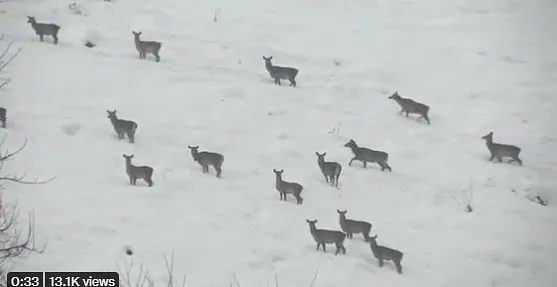Srinagar: In an encouraging sign, a herd of 40 to 50 Hangul ( Hangul or the Kashmir Stag ) were sighted at the Dachigam National Park here recently. The scene of the herd of Hanguls, which has gone viral on social media, has brought cheer to wildlife enthusiasts.
A video uploaded on Twitter by Regional Wildlife Warden Kashmir, Rashid Naqash shows a herd of around 40 to 50 Hanguls on the snow-covered slopes of the national park here.
“When I see a Hangul herd like this in Dachigam, the future seems bright!” Naqash posted alongside the video on Twitter.
Pertinent to mention that in an encouraging sign, a herd of 6 to 8 Hangul had been sighted in Naranag forest area of Wangath in Kangan in central Kashmir’s Ganderbal district on July 28, 2020.
Meanwhile, the fresh sighting of a large herd of Kashmir Stag, known locally as Hangul, an endangered species, has given hope that the conservation efforts of the Jammu and Kashmir government have started yielding positive results.
Talking to Greater Kashmir, Naqash said that this is a positive and encouraging sign that a large herd of Kashmir Stag or Hangul has been sighted here.
” The herd of Kashmir Stag was sighted on February 27 at Dachigam National Park here. We are hopeful about more such sightings in future and it is significant with regard to the measures taken by the government towards the conservation and preservation of its habitat ” Naqash said.
It looks obvious that the measures taken are yielding positive results, he said.
Hangul, cervus elaphus hanglu, is a critically endangered species found mainly in the Dachigam National Park and its adjoining areas in Kashmir. The male Hangul is characterised by the antlers and brownish red coat. The female Hangul do not have horns. It is the only survivor of the Red Deer group in the Indian sub-continent and its population has been on a decline over the years.
Dachigam National Park is said to be the last abode of critically-endangered Hangul which is known for its magnificent antlers with 11 to 16 points, and is the only surviving race of the Red Deer family of Europe in the sub-continent
The Hangul was widely found in the hilly and mountainous regions of Kashmir valley in the early 20th century with their numbers estimated to be around 5000.
However, due to hunting and encroachment of their natural habitat, the number fell to just around 150 in 1970.
The Jammu and Kashmir government, along with the IUCN and WWF, started a conservation plan titled Project Hangul.
The population of endangered Hangul, (Kashmir Stag) has registered a marginal increase in the Kashmir Valley, according to the latest Hangul population estimation census-2021.
The latest census conducted by the Department of Wildlife protection revealed a marginal increase in the Hangul population. The estimated population of the Hangul is now 261, compared to 237 in 2019.
Pertinently, in the last three consecutive surveys, conducted after every two years, the population of Hangul has shown a bit of an upward trend. In 2015, the population of (Kashmir Stag), Hangul was 186 while in 2017 and 2019, it was 197 and 237 respectively.
Officials said that at least 350 people from the wildlife department, students, volunteers and affiliated with NGOs conducted a fresh census-2021 of the endangered Hangul or Cervus elaphus Hangul to know the exact population of the animal.







